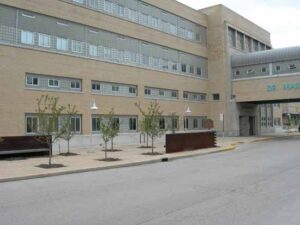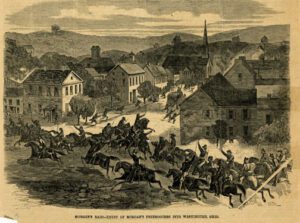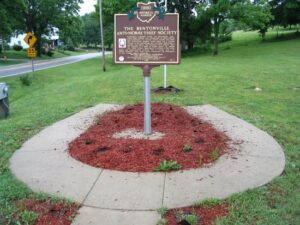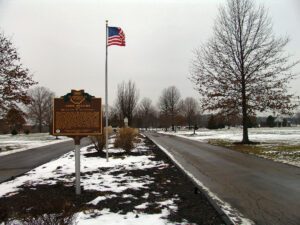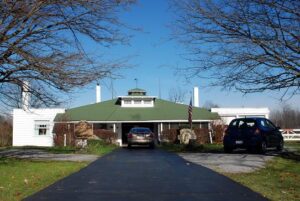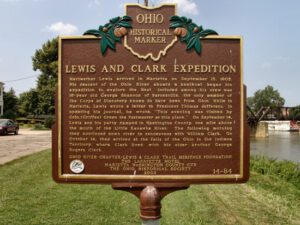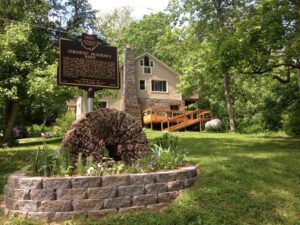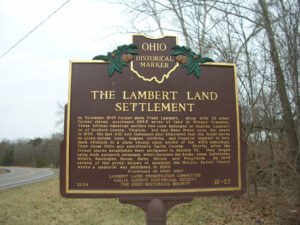, OH
The first railroad to operate west of the Allegheny Mountains was Toledo’s colorful “Erie and Kalamazoo.” Begun in 1832, the line was completed by 1836. Its rails were made of oak topped with thin iron strips. Horses pulled small railcars the 30 miles between Toledo and Adrian, Michigan. In July, 1837, a steam locomotive replaced the horses.
, OH
Founded November 8, 1815 by General Joseph Darlington and named for his Virginia birthplace, Winchester was incorporated in 1864 and later became the eastern terminus of the Cincinnati and Eastern Railway (1877-1880). The first locomotive to enter Winchester, the “Dick Thomson,” was named after a local businessman who was largely responsible for building the railroad. Winchester was also the birthplace of Evelyn (Longman) Batchelder, first woman sculptor to become a full academician at the National Academy of Design in 1919.
, OH
Originally a vigilante group, the Bentonville Anti-Horse Thief Society was formed here in March 1853 by area landowners to recover stolen horses and mules and to prosecute thieves. Horse theft was a serious offense in the antebellum era. Trustees nominated a captain and riders, who received a $10 reward upon the capture of a thief or stolen horse. As horses lost their former importance in society in the early 1900s, the organization evolved into a social club. Its annual banquet, held each April, celebrates the continuity of this Adams County tradition.
, OH
Anson Williams visited Ohio in 1834 before he moved to Orange Township. A former resident of New York State, Williams purchased this site and the surrounding 1,000 acres of U.S. Military District lands and hoped to find opportunity for himself and his family. He bought the land for $6.00 an acre from James D. Wolf, who owned the 4,000-acre section three of Orange Township. The Village of Williamsville was laid out with 80 lots in 1836 on both sides of the Columbus and Sandusky Turnpike. Williams built his home and a hotel with a store and tavern. A hotel and tavern, owned by George Gooding and where the stage changed horses, had already been established north of Williamsville. Competition may have led to Williamsville’s decline. A church was built in 1845 and remained until 1900. Anson died in 1847, and his wife Hannah passed away in 1851. Both are buried in nearby Williamsville Cemetery.
, OH
Southern Park Stables, at 126 Washington Boulevard in Boardman, was the private training stable of Attorney David Arrel and was built circa 1912 to house his standardbred horses racing at Southern Park Trotting Track one block south. The Stables is the last remaining structure of a large complex known as Southern Park, which included not only the racetrack and accompanying stables, grandstand, and outbuildings, but a dance hall, picnic pavilions, and baseball diamonds. The park was a favorite destination for Youngstown city residents wishing to relax in the country, and many company picnics were held here. Janie S. Jenkins has lived at Southern Park Stables since 1946 and deeded it and 8.33 acres to the Boardman Township Park District in 1993 with restrictions that it be forever preserved. The wrought iron gates at the driveway entrance were originally the main entrance gates for the racetrack.
, OH
Meriwether Lewis arrived in Marietta on September 13, 1803. His descent of the Ohio River aboard a keelboat began his expedition to explore the West. Included among his crew was 18-year old George Shannon of Barnesville, the only member of the Corps of Discovery known to have been from Ohio. While in Marietta, Lewis wrote a letter to President Thomas Jefferson. In updating his journal, he wrote,”This evening was visited by Colo. [Griffen] Green the Postmaster at this place.” On September 14, Lewis and his party camped in Washington County, one mile above the mouth of the Little Kanawha River. The following morning they continued down river to rendezvous with William Clark. On October 14, they arrived at the Falls of the Ohio in the Indiana Territory, where Clark lived with his older brother George Rogers Clark.
, OH
In 1795, at the age of 23, Jeremiah Morrow came to the Northwest Territory from Pennsylvania. He purchased land along the Little Miami River in Deerfield Township and in 1799 married Mary Parkhill of Pennsylvania. Around 1800 he built this barn which is one of Warren County’s oldest standing structures. In 1801, Morrow was sent to the Second Territorial Assembly and to the first Ohio Constitutional Convention in 1802. In 1803, he was elected the new state’s first U. S. Congressman and was Ohio’s only congressman for ten years. In 1813 the Ohio legislature elevated him to U.S. Senate. In 1822 he became Ohio’s ninth governor. He went on to serve in both the Ohio House and Senate and at age 69 returned to Congress. An extraordinary man, Jeremiah Morrow gave his country 43 years of public service.
, OH
In November 1843 former slave Frank Lambert, along with 29 other former slaves, purchased 265.5 acres of land in Morgan Township. These African American settlers had once belonged to Charles Lambert Jr. of Bedford County, Virginia, but had been freed upon his death in 1839. His last will and testament also stipulated that the freed slaves be given horses, oxen, wagons, clothing, and financial support to help them relocate to a state chosen upon advise of the will’s executors. They chose Ohio and specifically Gallia County. Shortly after the former slaves established their settlement in Section 32, they began using their authentic surnames, which included the Burks, Jones, Leftwiches, Millers, Randolphs, Reeds, Sales, Minnis, and Wingfields. By 1845 several of this group helped to establish the Morgan Bethel Church where a memorial was dedicated in 2002. (continued on other side)


